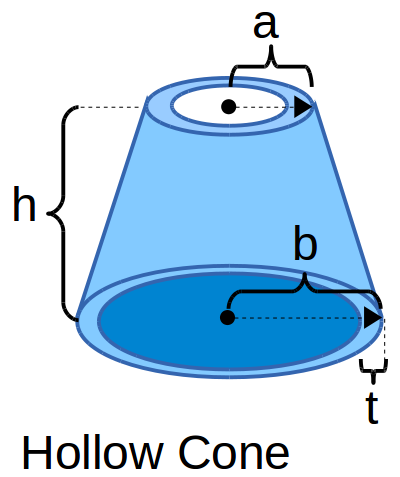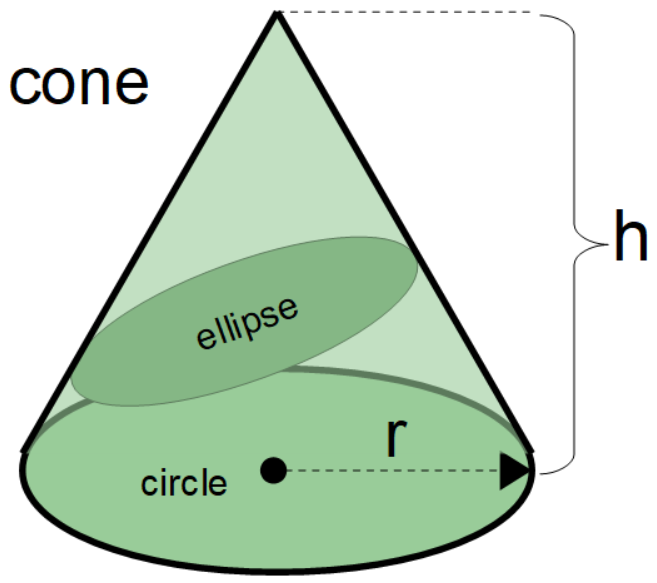The Weight of a Cone Shell calculator computes the mass (weight) of the shell of a right circular cone or cone frustum defined by a top radius (a) and base radius (b), height (h) in between, the thickness (t) and the mean density (mD). NOTE: NEW DEFAULT UNITS.
INSTRUCTIONS: Choose units and enter the following:
- (a) Top outer radius
- (b) Bottom outer radius
- (h) Height of the cone or cone section
- (t) Thickness of the shell
- (mD) The mean density of the substance of the cone (CLICK HERE).
Cone Shell Weight (M):The calculator computes the mass/weight of the cone in kilograms. However, this can be automatically converted to numerous other mass/weight units (e.g. pound, tons) via the pull-down menu. Note: For a complete cone, simply let the top radius (a) remain as zero.

The Math
Note: the frustum is created by parallel planes that go through the cone and are normal (perpendicular) to the center axis of the cone. The planes are separated by the height (h). The formula for the Volume of the Frustum of a cone is as follows:
V = 1/3 • π • h(a2+a•b+b2)
The Mass of a Cone Shell calculator:
- Computes the Volume of the shell
-
- Computes the Volume of the Outer Shell
- Subtracts the Volume of the Inner Shell
- Uses the volume times the density to compute the mass or weight of the shell
NEW DEFAULT UNITS
As of 16 July 2024, the default input units have been changed from meters (m) to millimeters (mm) and the default density of material has been set to 7850 kg/m3, which is the density of steel. This change was made to accommodate the most frequent users of this calculator.
Mean Density Table
| Common Mean Densities in Kilograms per Meter Cubed (kg/m3) | ||
|
Fluids
Fuels
Market-Ready Grains |
Metals
|
Earthen
Synthetic
Organic
|
| Mean Density Lookup Function | ||
Mean density is scientifically volume divided by mass. There are various unit for density adopted by cultures and industries. Common units for density included the following:
- kilograms per cubic meter (kg/m3)
- grams per cubic centimeter (g/cm3)
- grams per liter (g/L)
- pounds per cubic feet (lb/ft3)
- ounces per cubic inch (oz/in3)
- pounds per barrel (lb/bbl)
- pounds per bushel (lb/bu)
If you want to identify a material by its density, use the Density Within Range tool.
- Cone Surface Area based on cone height and cone base radius
- Cone Volume based on cone height and cone base radius
- Cone Mass or Weight as a function of the volume and mean density
- Cone Frustum Surface Area based on the two heights and two radii
- Cone Frustum Volume based on the two heights and two radii
- Cone Frustum Weight or Mass based on the cone frustum volume and mean density
- Cone Shell Volume a.k.a. hollow cone volume
- Cone Shell Mass or Weight a.k.a. hollow cone mass
- Moment of inertia of a cone shaped object based on mass and rotation axis
- Moment of inertia of a cone shaped object based on mass and distance to apex (rotation around apex)
- Compute the total surface are of the frustum of a cone: This includes the top and bottom surfaces.
- Compute the lateral surface area (using L) of the frustum of a cone.
- Cone Frustum Volume from Angle
- Cone Frustum Height from Volume and Outer Side Angle: Computes height based on volume, small radius and outer side angle.
- Cone Frustum Height from Volume and Inner Side Angle: Computes height based on volume, small radius and inner side angle.
See Also
- Frustum Calculator - Equations for volume, mass and surface areas for various frustums.
- Volume Calculator - Volume equations for various geometric shapes
- Mass Weight Calculator - Equations for the mass and weight of objects based on their mean density and shape
Reference
- Equation 4.42 Spiegel, Murray R. "Chapter 4." Mathematical Handbook of Formulas and Tables. New York: McGraw-Hill, 1968. N. pag. Print.
